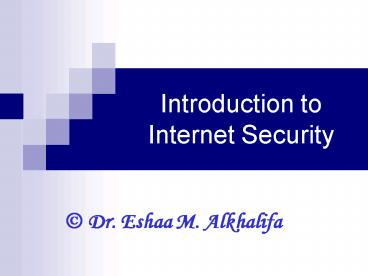Introduction to Internet Security - PowerPoint PPT Presentation
1 / 14
Title:
Introduction to Internet Security
Description:
People who have a lot of time on their hands and curiosity to learn more about ... Wash it CCLEANER is an option. Use a virus checker; bit defender, Kaspersky, Fprot, ... – PowerPoint PPT presentation
Number of Views:2109
Avg rating:3.0/5.0
Title: Introduction to Internet Security
1
Introduction toInternet Security
? Dr. Eshaa M. Alkhalifa
2
Who are Hackers?
- People who have a lot of time on their hands and
curiosity to learn more about computers and
applications
3
Why do they hack?
- Its a challenge
- Vengeance
- Special interest groups religious, etc.
- Industrial espionage against rival companies
- Warfare
- Censorship
4
Attacks by using the web normally
- Denial of service aimed at routers or servers
- SPAM unsolicited email messages. Newer
variations include instant message spam,
newsgroup spam, search engine spam, weblogs spam
and mobile phone spam. - Email Bomb overwhelming an email address such
that it becomes unusable. - Spoofing To pass oneself as someone else. E.g.
use someone elses user name and password, use
someone elses IP address (IP spoofing) or man in
the middle attack.
5
Phishing and Identity Theft
- Phishing The act of masquerading or web page
spoofing. Getting a copy of the web site in
detail, and the using it instead of the real one
to obtain credit card details etc by making
people believe it is the real one. - Identity Theft and Stalking Using details that
belong to someone else to gain credit or buy
goods or services. This includes credit card
details or bank statement details. Thieves take
loans, or purchase good based on the identities
of others.
6
Other ways
- Session Hijacking Once a user starts a session
with a server and gets the session ID, that ID is
hijacked and the hackers computer pretends to the
be the computer that started the session. - Social Engineering To obtain information from
the person like username/password either through
lying, tricks, or simply by reading what another
person types on the keyboard.
7
Getting CMD rights
- SYN Flood Flooding a server with requests, to
make the server crash, or to execute commands on
the server. Hacking tools called rootkits are
the used to be installed on the computer to gain
control.
8
Malware it includes
- Viruses
- Worms
- Trojan Horses
- Spyware
9
Viruses
- Programs that can replicate themselves
- They attach themselves to other programs like exe
programs or files. - File infecting viruses can use macro-enabled
documents and spread by email or removable disks
such as flash disks. - The main language used to write viruses is VBA
although others have been used to. - A boot virus infects the boot sector and then
spreads out from there.
10
Worms
- Capable of self replication but do not attach
themselves to executable because they are self
contained. - A worm has tasks built into it called payloads,
e.g. deleting files, carrying messages, sending
documents through email. A worm can also open
backdoors. - A worm with more than one payload is known as
being multi-headed. - Even simple worms can slow a system down just by
multiplying.
11
Trojan Horses
- Malicious piece of software that is pretending to
be a legitimate program. - The user is tricked into running this program,
which allows the program to damage the computer.
- These programs are also used to open backdoors
for access to the computer resources or perform
spying functions. - Cross Site Scripting (XSS) placing malicious
scripts on a trusted site zone.
12
Spyware
- Software or hardware placed on the victims
computer to later gather information about that
victim without their knowledge. - It is broken down into two types
- Surveillance when companies monitor their
employees computer usage. - Advertising Spyware the spyware sends the
browsing data obtained from the victims
computers to the spyware company which then uses
that data to display advertisements based on the
victims preferences.
13
Ways to spy
- Key Logging Installing an invisible software
that records all keystrokes made by the user of
the computer. There are hardware and software
versions of key loggers. - Screen Capture
- Trojans
14
How to take care of your device
- Use a Defragmenter diskeeper,e.g.
- Wash it CCLEANER is an option
- Use a virus checker bit defender, Kaspersky,
Fprot,.. - Use a firewall to close open ports and control
the system, bit defender, zone alarm.

